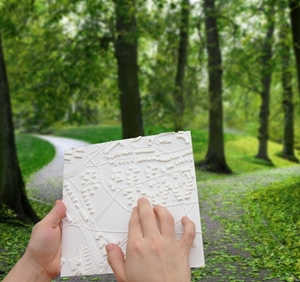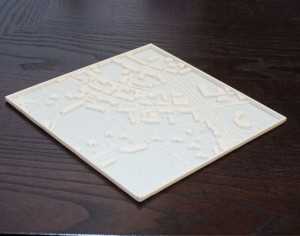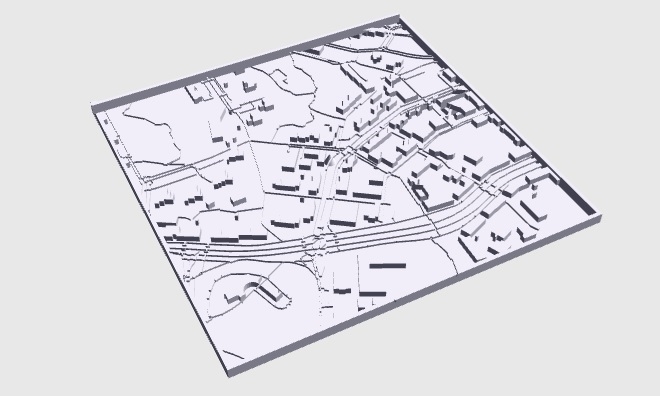Touch Mapper: 3D Printed Tactile Maps Allow the Visually Impaired to Orient Themselves in Any Location
 Sometimes it’s hard to tell if it’s coincidence or the start of a trend, but in 3D printing news, certain topics seem to suddenly be everywhere at once. Lately, stories about 3D printing applications for the visually impaired have been coming out of the woodwork, and I love it. A couple of weeks ago we covered Linespace, a tactile tablet that allows blind people to interact with maps, diagrams and other visual data. One thing that limits Linespace, however, at least in terms of maps, is its size; it’s definitely not portable. The beauty of a map is that you can take it with you and use it to orient yourself in any location.
Sometimes it’s hard to tell if it’s coincidence or the start of a trend, but in 3D printing news, certain topics seem to suddenly be everywhere at once. Lately, stories about 3D printing applications for the visually impaired have been coming out of the woodwork, and I love it. A couple of weeks ago we covered Linespace, a tactile tablet that allows blind people to interact with maps, diagrams and other visual data. One thing that limits Linespace, however, at least in terms of maps, is its size; it’s definitely not portable. The beauty of a map is that you can take it with you and use it to orient yourself in any location.
A Finland-based designer named Samuli Kärkkäinen has created an application to help the visually impaired orient themselves via maps in any location. Touch Mapper is a simple tool that 3D prints tactile maps using map data from OpenStreetMap. Just enter the address that you want to map out, and Touch Mapper will instantly bring it up. You can drag and adjust the map if you need to, then click “create tactile map” and the site will show you the 3D model of the map. At that point, you can 3D print the map yourself or order a print from 3D printing service Playful Pixels. Normally, a map from the service costs €42; but they’re currently being sold at a discounted €35.
This certainly isn’t the first time we’ve seen 3D printing used to create maps for visually impaired people; just the other day we wrote about 3D printed Braille campus maps at Rutgers University. Touch Mapper’s maps are different in that they’re very visually oriented. The tactile maps are finely detailed and include representations of buildings, railways, roads, and waterways. Varied heights and textures differentiate the different topography; most bodies of water are represented by wavy surfaces, while smaller streams are just narrow lines. Pedestrian roads are raised higher than other roads, as the visually impaired utilize them more frequently. The user’s selected address is marked as a raised cone, and the map’s northeast corner is specially marked to ensure proper orientation.
A lot of people find maps to be obsolete thanks to GPS devices, and it’s true that visual maps have become less necessary than they used to be. However, even with a voice telling you exactly where and when to turn and how far to go, it’s still tremendously helpful to have a visual representation of where you are, and where natural features and buildings are in relation to your position. That’s something the visually impaired don’t have currently.
 Touch Mapper offers two different scales for its printed maps. Normal, or 1:3100 scale, is best, Kärkkäinen says, for those who can read Braille or have been blind from a young age and are accustomed to using tactile tools. Large, or 1:2400 scale, is better for those who have lost their sight relatively recently or who cannot read Braille. Currently, the maps are printed as PLA squares sized 17 x 17 cm, but additional sizes will be available at a later time.
Touch Mapper offers two different scales for its printed maps. Normal, or 1:3100 scale, is best, Kärkkäinen says, for those who can read Braille or have been blind from a young age and are accustomed to using tactile tools. Large, or 1:2400 scale, is better for those who have lost their sight relatively recently or who cannot read Braille. Currently, the maps are printed as PLA squares sized 17 x 17 cm, but additional sizes will be available at a later time.
Touch Mapper is in beta right now, and Kärkkäinen welcomes questions and feedback via email at info@touch-mapper.org. Delivery of maps is expected to be pretty quick; the maps print in one to two days, and delivery within Europe should take less than a week (or only a day in Finland). International delivery might take a few weeks, but that’s nothing new. Try it out! What do you think of this new technology? Discuss in the 3D Printed Tactile Maps for Visually Impaired forum over at 3DPB.com.
Subscribe to Our Email Newsletter
Stay up-to-date on all the latest news from the 3D printing industry and receive information and offers from third party vendors.
Print Services
Upload your 3D Models and get them printed quickly and efficiently.
You May Also Like
Josh Makeshift and the New Gold Standard 3D Printing Content Creation
In the beginning, 2007 or so, 3D printing videos were almost wholly absent from the web. Then, here and there, makers started to upload pictures of their rickety RepRaps and...
Teen Developed Desktop 3D Printing Extruder
Inexpensive desktop 3D printing extrusion has always been an impactful potential ally to 3D Printing users. Filabot and 3Devo have been trying to make this a reality for years, with...
Polymaker Unveils HT-PLA & HT-PLA-GF Line of 3D Printing Filaments
Today, Polymaker has launched a new line of HT-PLA & HT-PLA-GF filaments. These enhanced PLA versions increase the glass transition temperature of PLA from a normal 60°C to above 130°C....
3D Printing News Briefs, May 17, 2025: Color-Changing Materials, Humanoid Robot, & More
We’re covering research innovations in today’s 3D Printing News Briefs! First, Penn Engineering developed 3D printed materials that change color under stress, and UC Berkeley researchers created an open source,...

































